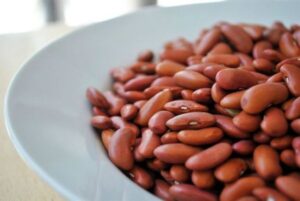Short on Time? These 3 Beans Don’t Need Soaking

Beans and legumes—those magical fruits—are tragically underutilized in the Standard American Diet. They aid in disease prevention, weight loss, energy boosting, and overall vitality. Best of all, they’re vegan and very cheap to buy, especially in bulk. Many people avoid buying dried beans in bulk because they require soaking before boiling, a process which can take hours. Fortunately, there are some legumes out there that don’t require any soaking at all; just take them home and boil them at once.
LEGUMES FOR HEALTH
From a holistic health perspective, the color of the bean corresponds to the organs it supports best. Green legumes, such as green lentils, split peas or mung beans, support the liver (as do other green foods like sprouts, leafy greens and herbs). Red beans like adzuki or kidney beans support the heart (as do red bell peppers, berries and tomatoes). Yellow beans like chickpeas or soybeans support the spleen-pancreas; and white beans like navy beans support the lungs. Corresponding colors for corresponding organs – it’s a brilliant concept that rings true in alternative nutrition practices.
TO SOAK, OR NOT?
But enough about nutrition. We’re talking about cooking here; and more importantly, we’re talking about convenience and speed. Almost all dried beans require soaking before cooking them, as they need to be pre-digested before you eat them… otherwise you end up with flatulence, indigestion and less nutrients absorbed by your body. The soaking time for dried beans runs anywhere from two hours to twenty-four, depending on which method you choose. As an avid bean-lover, I cook them from dried bean about twice a week… but as a full-time worker with a never ending to-do list, I rarely cook those long-soaking beans.
THE 3 THAT DON’T NEED TO SOAK
Instead, I keep three beans stocked in my kitchen at all times, the three legumes that don’t require soaking. Here are the most common beans that don’t require soaking before you cook them from dried bean:
1) LENTILS
Next to soybeans, lentils have the highest protein content of any legume. They reduce cholesterol, control blood sugar and have anti-cancer qualities. They’re extremely cheap to buy dried from the bulk section (usually around $1-2 a pound), and they cook in just about 15 to 30 minutes flat. Use lentils in soups and stews, but also in curries and salads. Overcook them slightly and add them to minced vegetables and egg or ENER-G for a meatless burger patty. Lentils are low-cal, fiber-rific and rarely give individuals gas, as other beans can.
2) ADZUKI BEANS
Also spelled azuki or aduki, these Japanese beans are my absolute favorite. Commonly found in Asian-inspired dishes or raw/vegan restaurants, these red beans have a slightly earthy, sweet flavor that lends them well to dessert dishes—you’ll commonly find donuts, custards and pastries in Asian markets made with red bean paste, which comes from the adzuki. From dried bean, they take about 90 minutes to cook, but it’s well worth the wait. Make a large batch at the beginning of the week and keep them in the fridge for various recipes. Adzuki are great for cucumber/seaweed salads, tossed into tempeh stir-fries, added to fall stews and cooked with sweeteners and milk as a dessert pudding.
3) YELLOW SPLIT PEAS
Split peas aren’t just for soup—although they are simply fantastic in soup. Depending on your split peas and what recipe you’re using them in, they’ll take anywhere from 30 to 45 minutes to cook. Use them in soups, of course, but also instead of chickpeas for a wonderful hummus spread. Or add them to any lamb stew recipe for delicious results and much-needed fiber. Use them in virtually any veggie patty recipe—fritters, burgers or pancakes.
Image: cookman17

